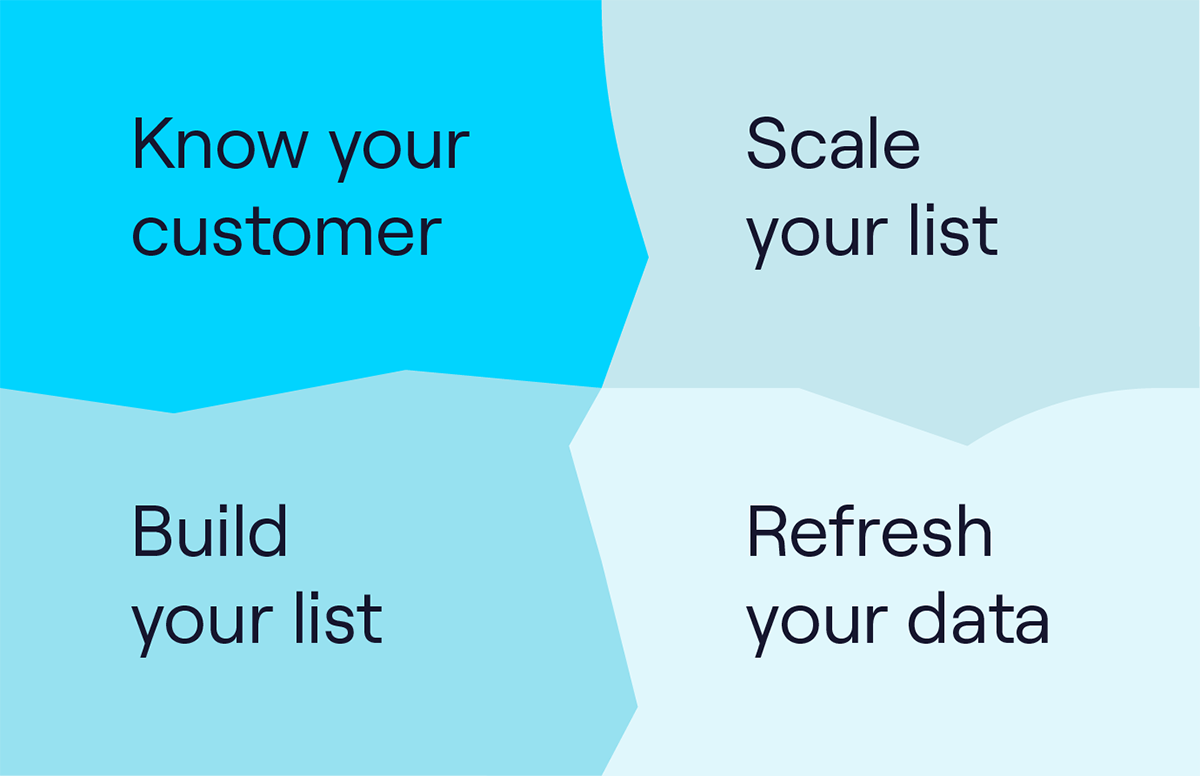Is Buying Email Lists Worth It?
Email lists are essential for driving email marketing campaigns, sales outreach, and various lead-generation initiatives, but they can be costly and vary in quality.
This leads to the question — is buying email lists worth it?
And at times, is this even legal?
In this article, we’ll answer these questions and provide tips for separating valuable email lists from the snake oil.
What are email lists?
An email list is a collection of email addresses businesses use to send emails to a targeted group of people, usually for marketing purposes.
For example, a sales consultant might have an email list of COO’s from medium businesses in their target industry.
By giving you a direct line to similar leads, lists are valuable for personalised outreach.
There are two ways to develop an email list:
- Build it yourself with lead capture forms — a slower option. However, the emails you capture are high-quality since the person opted in to receive emails from you.
- Purchase email lists—this is a fast yet riskier and more expensive option. If you buy an email list from the wrong service provider, it could be non-compliant or contain many duds.
Some email lists also include additional contact information, such as their name, job title, phone number, and other relevant details that aid outreach.
If you’re considering buying an email list, it’s a good idea to learn the best way to go about it.
Otherwise, you risk poor data quality, which may cause legal troubles and result in hefty fines for your business.
Is it illegal to buy email lists?
Purchasing email lists can be illegal, depending on how you collect and use them.
Under laws like the EU’s General Data Protection Regulation (GDPR), sending unsolicited emails to people without their consent is prohibited. Suppose the email list contains personal information collected or scraped without explicit consent. In that case, authorities can impose severe fines on you—up to 20 million euros or 4% of your annual global turnover, whichever amount is higher.
Some email marketing platforms will even ban you from their software if you use a non-compliant email list, as this can cause their brand to be associated with spam and low open rates.
This isn’t a legal penalty, but having to find and transition to a new platform is annoying.
There are service providers from whom you can buy lists legally.
Not all of them are backwoods moonshiners bootlegging absinthe.
Cognism, for example, offers prospecting lists that are entirely legal and compliant with GDPR and other critical regulations. They are also highly accurate, so you get your money’s worth.
As a rule, always check with local regulations around data privacy and ask your vendor if they remain compliant with these regulations.
“Cognism is our comfort blanket when it comes to compliance. Whenever a prospect asks where we get their data from, we can confidently say that we’ve sourced their information from a reputable ISO 27001 and SOC Type II certification data company." “With Cognism, you aren’t snowing yourself under with ICO complaints. I couldn’t recommend it enough.”
How do you buy an email list?
No one wants to be the poor sap who walks into a jeweller and pays a premium for a diamond that turns out to be a stolen, lab-grown amethyst.
Therefore, you should learn to identify a high-quality email list.
Here are some factors to consider when picking your email list provider:
Source of the list
Ensure the list provider collects data ethically and obtains consent. A reputable provider clearly explains how they gather contacts and whether they have consent for marketing purposes.
💡 Find out how to do GDPR marketing right.
Data accuracy
Verify that the list is up-to-date, relevant, and contains valid email addresses. Outdated or incorrect data can result in high bounce rates, damage your sender reputation, and harm future email deliverability.
Target audience fit
Confirm the list matches your ideal customer profile or target market. Buying customer lists that don’t align with your audience will waste resources and lead to low engagement rates.
Legal compliance
Ensure purchased email lists adhere to GDPR, CAN-SPAM, and other relevant privacy regulations. Non-compliance with these laws can lead to hefty fines and damage your business reputation.
Complementary data
Check if the lists also provide mobile numbers, job titles, firmographics, and other B2B data points to help you personalise your email outreach and connect with leads through different channels.
Most B2B data providers will happily hop on a phone call with you to discuss these considerations. If they’re hesitant or shady about it, that’s a red flag.
Some businesses, like Cognism, even allow you to sample their email data.
If that’s an option — take it!
This way, you can test the product before buying it, ensuring that it contains leads that fit your ideal customer profile and emails that land in their inboxes, not the ether.

“Our bounce rate benchmark is 7%, Cognism comes in at 6%. Our conversion rate benchmark is 14%, and Cognism comes in at 29%. Having high-quality data is not a nice to have. It’s a must-have.” “Cognism is our lead platform in our lead gen stack.”
Are email lists worth buying?
In many cases, it’s better to build your own targeted marketing list or create one with a reputable B2B data provider like Cognism, ZoomInfo or Kaspr.
When you buy a targeted marketing list from elsewhere, you’ll likely experience inaccurate data, compliance issues, and poor-quality leads.
So it pays to know what to look out for!
Let’s go ahead and cover the three common problems with any email list purchase👇
Inaccurate data
Traditional lists are known for outdated and inaccurate email data, which leads to high bounce rates and low email deliverability.
This wastes your marketing budget and frustrates SDRs and marketers who took the time to craft those emails.
Compliance issues
Many email list sellers don’t take compliance with laws seriously.
For example, they may collect personal information without consent.
Depending on your region of operation and the local privacy regulations, this might mean you’re working with non-compliant B2B data and, as a result, a source of steep fines.
Even if your purchased list is compliant, no business owner wants the cloud of doubt hanging over them whenever they launch an email campaign.
Poor quality leads
Some lists are sold to thousands of buyers, meaning the contacts on that list are the unlucky recipients of thousands of marketing emails from random businesses.
A crowded inbox is more challenging to stand out in.
Some providers may also claim to contain leads that fit your ideal customer profile when that isn’t the case.
This causes you to email people who do not need your product or service.
Reasons to buy an email list
Fortunately, reputable B2B email list providers provide accurate, up-to-date lists that comply with relevant regulations and contain leads in your target audience.
If you can find one of these, it’s usually worth it!
Especially when email remains one of the highest ROI forms of marketing out there.
According to a recent survey, marketers earn an average of $36 for every $1 they spend on email marketing.
And email marketing relies on correct email addresses, making quality email lists a valuable investment for any business.
“Our open rates used to be between 2-6%. Now they range from 40% to 60%. Working with a database that has a pool of verified emails makes my job as a marketer easier.”
How to legally get email lists?
Consider using a compliant B2B contact database like Cognism to get legal email lists.
The platform comes with a filtering system that allows you to quickly build targeted lists of legally sourced verified email addresses.
Here are some other general guidelines for building or buying email lists legally:
Third-party list providers
If purchasing email lists from third parties, ensure they comply with data privacy laws. Preferably, the contacts will have opted in to receive communications from third parties.
Consent-based collection
Seek explicit consent from individuals before collecting their email addresses. Do this with opt-in forms, sign-up pages, or by asking for permission directly online. To be extra safe, use a double opt-in process, where the person confirms their email address by clicking a link in a confirmation email.
Privacy policy
Clearly outline how you will use, store, and protect email addresses in your privacy policy. This ensures transparency and compliance with privacy laws like the GDPR (General Data Protection Regulation) and CCPA (California Consumer Privacy Act).
Avoid data scraping
Don’t use web scraping or other unethical methods to collect email addresses or personal information. Scraping websites for email addresses without permission can be illegal in some jurisdictions.
Leverage legal directories
Obtain emails from public directories where people have explicitly listed their contact information for business or professional purposes. Ensure you comply with relevant laws and provide an easy way for users to opt-out.
Try Cognism’s email list database
The answer to the question: is buying email lists worth it?
Yes, with a reputable provider like Cognism! Its B2B database makes creating compliant email lists that help you reach high-quality leads easy.
Use its AI Search and filters to find contacts that match your ideal customer profile, then export your list to your CRM or sales engagement tool for outreach.
You can even use its CRM enrichment feature to update the email address field of your contact records automatically.
It’s as simple as that.
With Cognism, say goodbye to suspect, inaccurate, and outdated contact information and hello to high-quality leads.
Sign up today and get:
- Validated emails.
- EMEA, NAM and APAC coverage.
- GDPR compliance.
- AI-powered insights tailored for every user.
- The largest mobile dataset on the market.
- Phone-validated mobile numbers.
Click 👇 to speak with our team.


.jpg)
